 |
|
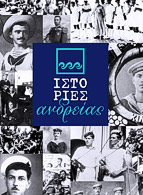 |
|
"Stories of Valour". An innovative exhibition of FHW, at the «Hellenic Cosmos» Cultural Centre with precious exhibits from the Greek Navy.
The "Stories of Valour" presents another approach to the history of the Greek Navy, as it evolves from the years of the Revolution of 1821 to the present day. In the wreck of a ship, which composes the exhibition scene, develops all the major episodes of the route of the Navy, through unknown small stories. Selected objects, never exposed before, are presented together with photographs, audio and video documents, so that visitors can participate with all their senses, understand, be moved and reflect. The new exhibition, an FHW production, at the Cultural Centre "Hellenic Cosmos" from February 16, 2016.
|
|
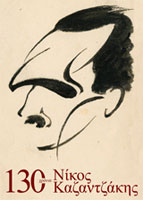 |
|
130 Years Nikos Kazantzakis
"Hellenic Cosmos", in collaboration with Kazantzakis Editions and the Nikos Kazantzakis Museum, present for the first time in Athens, an exhibition-tribute to the great Greek author, entitled "130 years Nikos Kazantzakis". The exhibition presents the life, travels and work of the universal writer, through his first editions, rare photographs, manuscripts and personal items, many of which are exhibite
for the first time.
6 December 2012 - December 2013
|
|
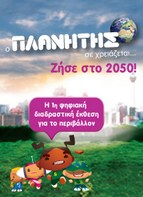 |
|
Your Planet needs you! Live in 2050
An interactive multimedia exhibition presented by "Hellenic Cosmos" in collaboration with ACT. The exhibition, which will last until late June 2013, was first presented at the Science Museum in London and received over 1.5 million visitors worldwide. It explores how our lives could be affected by the changes in our planet and the role of science and technology in humanity's efforts to adapt. As part of the exhibition, a journey into the future, in the city of 2050, takes place. Finally, new inventions suggesting different ways of using the planet's resources, are presented.
From 21st April 2013 at "Hellenic Cosmos"
|
|
|
 |
|
Ice Station Antarctica
The exhibition "Ice Station Antarctica" comes from the Natural History Museum of London and, through various challenges and activities, transports visitors to the coldest continent on the planet. Visitors are invited to experience the extreme conditions that scientists have to face there, to discover everyday life, to drive snowmobiles, to dive into the frozen sea and to study wild animals. The exhibition was developed in partnership with the British Antarctic Survey (BAS), Ice Station Antarctica was one of the highlights of the UK's involvement in International Polar Year (2007/2008). It is the best organized exhibition designed on a European level about Antarctica. With the support of ATTICA ZOOLOGICAL PARK.
(Period: October 2012-20 May 2013)
|
|
|
 |
|
Is there an Answer to Everything? A journey to the world of Greek mathematics.
The exhibition deals with the development of mathematics and mathematical thought in the ancient Greek world. Through the use of new technologies (video, digital interactive applications, Virtual Reality exhibits) and the adoption of modern museological conceptions, the exhibition attempts to demonstrate the importance of ancient Greek mathematics for Hellenic and European culture. The tour starts from the 6th century BC and culminates in the 4th century AD, examining all the significant "events" and people in the history of Greek mathematics. There is a brief reference to pre-Hellenic mathematics of the Egyptians and the Babylonians, as well as to the course of the texts of Greek mathematicians after the end of the ancient world, from the Byzantine monasteries and the Arab copying workshops to the European Renaissance scientists and the period of Scientific Revolution. The presentation of scientific applications in astronomy, mathematical geography and music create a more complete image of ancient Greek mathematics.
(Period: March 2003-20 March 2013)
|
|
 |
|
Ecosmosis
The exhibition Ecosmosis, which will bring the cycle of actions "Against all odds (AOO)" under the title "Ethics/Aesthetics" to its completion, will take place at Building 1 of Hellenic Cosmos from the 30th of May to the 30th of June 2012. In an artistic 3D interactive environment, architecture is invited to examine issues that are related to society, ecology and culture. Acclaimed Greek architectural firms with significant work in ecological design will participate in the exhibition.
(Period: 30 May-30 June 2012)
|
|
|
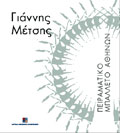 |
|
Giannis Metsis - Experimental Ballet of Athens
Exhibition dedicated to a great man of dance, the dancer, choreographer and teacher Giannis Metsis is presented by Hellenic Cosmos with the cooperation of the Peloponnesian Folklore Museum. Giannis Metsis, a dancer with international career in classical dance, introduce with his choreography works the neo-classic ballet in Greece. The exhibition presents unknown material from his personal archive: costumes, items, models of costumes, performances programmes, photographs, notes and audiovisual material. The exhibition is accompanied by the educational programme "Choreographing the music", specially created for students of all ages.
(Period: October 2011-June 2012)
|
|
|
| |
|
Myths and Monsters
Which creatures really existed and which are the product of man's imagination? Where do the limits between reality and fantasy lie? What urges the human mind to create these shapes? The exhibition "Myths and Monsters" attempts to answer these questions. The exhibition comes, for the first time in Greece, from the Natural History Museum of London to Hellenic Cosmos. In an area of 600m2 impressive animatronics in natural size, models, showcases with fossils, graphics and photographs bring to life some of the most known ancient myths. An exciting journey to myth and history for both children and adults.
(Period: October 2011-February 2012)
|
|
|
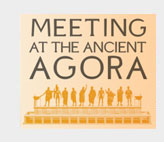 |
|
Meeting at the Ancient Agora
The exhibition "Meeting at the Ancient Agora" focused on the values that were born in the Ancient Agora of Athens and shaped modern political thinking: freedom, justice, education, isonomy, freedom of speech, sociability and contribution to the common life of the state. With natural exhibits and interactive applications of state-of-the-art technology the social, political and intellectual life of Athens comes to life in the period in which the Agora was created. The exhibition covered mainly the classical and Early Hellenistic Period (approximately 5th-3rd century BC), while there was mention of the historical course towards the creation of the Agora and to its use in later periods, for example the Roman period. The exhibition also presented the way contemporary Europe and the world community have incorporated into their institutions the fundamental characteristics of the institutions that were born in the Ancient Agora of Athens.
(Period: December 2007-September 2011)
|
|
|
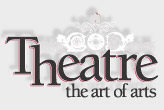 |
Theatre, the art of arts
Dramatists, actors and roles, settings, costumes and masks, colours,
lights and music co-exist in FHW's exhibition, where the theatre
is examined as the combination of many artists on the stage in order
to create the visual and sound environment of the performance. The
theatre is presented through a new perspective, providing visitors
with the opportunity to discover aspects that were not visible at
first and to follow the "adventure" of a play from its printed form
to the stage. Important theatrical "schools", significant play
writers, influential plays and remarkable roles are presented
through texts, photographs of -mainly- Greek performances, costumes
and extracts from plays, familiarize visitors with the history of the
western theatre, but also of the Greek one from the Classical period
to the present days.
(Period: January 2006-September 2011)
|
|
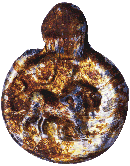 |
|
Magic and Byzantium
Photographs, drawings of objects and texts of Byzantine scholars were the material of the exhibition "Magic and Byzantium", which attempted to approach the phenomenon of magic through the eyes of the Byzantines. The exhibition was organized in the framework of the celebration of the European Heritage Days (24 to 26 of September 2010), which this year is entitled "Wizards, spells and amulets: Magic in the ancient and Christian world".
(Period: September-October 2010)
|
|
|
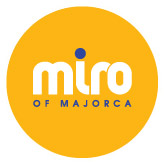 |
|
Miró of Majorca
Miró of Majorca
The exhibition "Miró of Majorca", with works of the great Catalan painter that appeared for the first time in Greece, was hosted at "THEATRON" of Hellenic Cosmos" from the 22nd of February to the 6th of June 2010. The exhibition included works by Miró from his mature period in his workshop in Majorca: selected oils from the period 1976-1981, original engravings from the series Els gossos (The dogs), Gens de la mer ('People of the Sea), Fundació Palma, as well as photographs by Jean-Marie del Moral and Francesc Catalá-Roca, which immortalized the artist in his workshop. At the same time, the documentary "The phosphorescent trails of snails" was shown, which was a flashback to that creative moment when Miró colored his dreams.
The exhibition was organized in cooperation with the Teloglion Foundation of Art of the Aristotle University of Thessaloniki and the Foundation Pilar i Joan Ģiró in Majorca and was under the auspices of the President of the Hellenic Republic Mr. Karolos Papoulias and the Spanish Embassy in Athens. Its curator was Mr. Marios Elefteriadis.
(Period: February-June 2010)
|
|
|
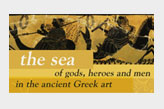 |
|
The sea of gods, heroes and men in the ancient Greek art
The exhibition "The sea of gods, heroes and men in the ancient Greek art" ("La mer des dieux, des hép;ros et des hommes dans l'art grec antique") constituted a journey to the sea through photographic depictions from ancient pottery. The visitor discovered a multitude of gods and heroes and extremely old myths, which are a source of inspiration for art and literature from Antiquity to modern times.
The inauguration of the exhibition took place on Wednesday 4 November 2009. At the same time, there was a lecture by Ms Aliki Samara -Kaufmann, Archaeologist and Special Collaborator in the Department of Greek, Roman and Etruscan Antiquities of the Louvre Museum, entitled "Journeys to ancient Greek ceramic: Myth and reality". The exhibition was designed and implemented with the contribution of the "Elia" association and the support by the French Institute.
(Period: November 2009-January 2010)
|
|
|
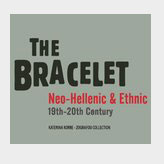 |
|
The bracelet: Neo-Hellenic and Ethnic (19th-20th century)
Exhibition of the bracelet collection of Katerina Korre-Zografou
From the 10th of November 2008 to the end of May 2009 Hellenic Cosmos hosted an exhibition with a collection of bracelets by the Professor of the University of Athens Ms Katerina Korre-Zografou. The exhibition was the first to be organized at the new exhibition areas of the "THEATRON".
It included more than two hundred bracelets of the 19th and 20th century, modern Greek and from other countries. Each one with a special story, reflecting known and unknown aspects of everyday life. In this way personal stories are the starting point for a deeper examination of wider historical and social issues, like population movement, since a lot of times the bracelets were found far from the place where they were created, but also issues that had to do with the social stratification, since jewels were a sign of their owners' prosperity.
(Period: Novemver2008-May 2009)
|
|
|
 |
Tales of the Olympic Games. A unique exhibition.
Focusing on the modern Olympic Games, from their revival in 1896 to the Athens organization in 2004, the exhibition attempted to enlighten the importance of the Games on individual, city, nation/state and world community level. Looking beyond stereotypes, the exhibition focused on personal stories of athletes, such as Spiros Louis, Konstantinos Tsiklitiras and Nadia Comaneci, on cities that had undertaken the organization of the Games, such as Barcelona and Moscow, on issues of exclusion from the Games and its relation to issues of economic or political strength. Multimedia, 3D graphics, Virtual Reality, words and images, as well as objects and special constructions created an attractive exhibition environment, where visitors had the opportunity to follow the course they preferred, but also to state their own view about the Olympic Games.
(Period: 2004-2006)
|
|
|
 |
Treasures through a piggy bank
The exhibition, through three units, photographic material and simple texts presented facts from the history of coin and from the economic history of the new Greek state. At the same time, it promoted the idea of savings and presented the history of the Greek Postal Savings Bank.
(Period: 2005-2007)
|
|
|
 |
|
Crusades: Myth and Realities
An important travelling exhibition of historical and archaeological content, designed and organized by the Pierides Foundation in Cyprus (coordinating foundation), the Foundation of the Hellenic World, the Superintendence of Cultural Heritage in Malta and the Instituto per le Technologie Applicate ai Beni Culturali-Consiglio Nazionale delle Richerche in Italy. The exhibition's subject was the influence of the Crusades to the Mediterranean cultures and vice versa, starting from their beginning in the 11th century until the expulsion of the Order of the Knights of St John from Malta in 1798. Over 200 findings were exhibited 'most for the first time' in an impressive castle-city, inspired by medieval models, which was designed by the exhibition's curator Mr. Giannis Toumazis. FHW participated in the exhibition designing and developing the multimedia exhibit "The World of the Crusades", which included digital pictures of real objects, maps and texts. The exhibition was created in the framework of the European Programme "Culture 2000".
(Period: February-June 2005)
|
|
|
 |
4000 years of Hellenic Costume
In co-operation with the Peloponnesian Folklore Foundation and Mrs Ioanna Papantoniou, FHW presented an exhibition on the diachronic evolution of the Hellenic costume through time, from Prehistory until the 1930s. The exhibition also included two Virtual Reality exhibits.
(Period 1999-2003) .
|
|
|
 |
Every year this day... National Events and Historical Memory
This was the first exhibition to be hosted at Hellenic Cosmos and proved to be the most popular exhibition in Greece, according to data by the Ministry of Education. On the occasion of the national anniversaries, the 28th of October and the 25th of March, the exhibition aimed at a modern approach of history and attempted a different interpretation of historical themes, outside schoolbooks.
The topography of the anniversaries, the hero, the celebration, the mass media, individual and collective memory constituted five units, which analysed and presented ways of remembering the historical past. The feeling that history is all around us and that it is reflected in our everyday environment, in the city, in museums, in art, in the mass media, offered the possibility, even to the most reluctant visitors, to feel that the past is not something remote and indifferent but something that concerns us all.
The theoretical design of the exhibition was based on two main ideas: that the historical past is particularly significant for the formation of the present and that every period adds its version of the past. How collective memory is created was the main idea around which the exhibition was developed.
(Period: 1998-2001)
|
|
 |
copyright © FOUNDATION OF THE HELLENIC WORLD |


















